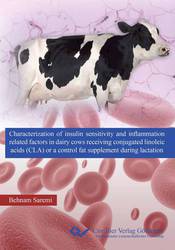| Areas | |
|---|---|
| Serie de libros (96) |
1378
|
| Nachhaltigkeit |
3
|
| Gesundheitswesen |
1
|
| Letra |
2364
|
| Ciencias Naturales |
5406
|
| Matemática | 229 |
| Informática | 319 |
| Física | 980 |
| Química | 1363 |
| Geociencias | 131 |
| Medicina humana | 243 |
| Estomatología | 10 |
| Veterinaria | 108 |
| Farmacia | 147 |
| Biología | 835 |
| Bioquímica, biología molecular, tecnología genética | 121 |
| Biofísica | 25 |
| Nutrición | 45 |
| Agricultura | 1004 |
| Silvicultura | 201 |
| Horticultura | 20 |
| Ecología y conservación de la tierra | 148 |
| Ciencias Ingeniería |
1793
|
| General |
98
|
|
Leitlinien Unfallchirurgie
5. Auflage bestellen |
|
Erweiterte Suche
Characterization of insulin sensitivity and inflammation related factors in dairy cows receiving conjugated linoleic acids (CLA) or a control fat supplement during lactation (Tienda española)
Behnam Saremi (Autor)Previo
Lectura de prueba, PDF (620 KB)
Indice, PDF (49 KB)
With the onset of lactation, dairy cows have to mobilize body reserves, mainly body fat, to cover the output of energy via milk. The homeorhetic metabolic adaptation to the needs of milk production is accomplished through the orchestrated action of hormones. In contrast to the “classical hormones” that knowingly control parturition, lactation and metabolism, the role and importance of messenger molecules originating from body fat (adipokines), of their receptors and also of nuclear receptors as key regulators of gene expression was only scarcely investigated in dairy cows. In particular, data on body fat were largely limited to subcutaneous (s.c.) fat from one location easily accessible via biopsy, whereas potentially heterogeneous reactions between different s.c. depots and also in different visceral (v.c.) fat were not yet comprehensively addressed. The aim of this dissertation was to characterize the mRNA expression of several adipokines and related factors that are involved in insulin sensitivity (IS) and in inflammation during the transition from pregnancy to lactation and during the subsequent lactation. In addition, dietary supplementation with either CLA vs. a control fat (supplementation period day 1 to day 105 or 182 of lactation) was tested for potential effects on the target mRNAs. The tissue in focus was adipose tissue (AT) with its different locations. Initially, suitable reference genes were identified as a methodological prerequisite for the studies. Using tissue samples obtained from both primiparous and pluriparous cows from animal experiments within a project cooperation, the time course of the mRNA abundance of 12 different target genes and 7 reference genes was characterized in s.c. fat and in liver from pluriparous cows and in three different s.c. and in three v.c. fat depots, in liver, skeletal muscle, and in mammary gland from primiparous cows. Two acute phase proteins, i.e. haptoglobin (Hp) and serum amyloid A3 (SAA3), were newly established as adipokines in cattle; both mRNAs yielded similar time course patterns with a peripartal peak. Treatment with CLA was mostly not affecting Hp and SAA3 mRNA expression; the decrease observed for Hp and SAA3 mRNA in 2 out of 6 fat depots tested indicates local anti-inflammatory effects of CLA. No CLA effect was observed for the Hp serum concentrations and for hepatic Hp mRNA. Indeed, we confirmed liver as the main site of Hp production. For the prioritization of nutrient uptake towards the mammary gland, IS in other peripheral organs is knowingly reduced. The mRNA expression of the target genes related with IS, i.e. adiponectin (ADIPOQ), leptin (LEP), their receptors (LEPR, LEPRB, ADIPOR1, ADIPOR2), of two nuclear receptor isoforms (PPARγ, PPARγ2) and of two pro-inflammatory cytokines (TNF-α, IL-6) in s.c.AT and in liver from pluriparous cows was mostly decreased from day 21 prepartum to day 21 postpartum in s.c.AT except TNF-α; in liver increases were observed for LEPRB and ADIPOR2, and decreasing abundance for all other hepatic target mRNAs except TNF-α and ADIPOR1 which remained constant in this time. In later lactation, prepartum values were reached again and were largely maintained until wk 36. The groups treated with CLA or control fat differed detachedly in mRNA abundance of PPARγ, LEPRB and TNF-α in liver and of PPARγ2 in s.c.AT; cows of the CLA group had also higher insulin concentrations and reduced systemic IS persisting after the end of CLA supplementation. In primiparous cows, changes with the duration of lactation were observed for most of the target mRNAs (except LEP) but not in all tissues investigated; time course and direction of change were partly divergent between the different tissues. CLA treatment for 105 days decreased the mRNA abundance of ADIPOQ, ADIPOR2, PPARγ2 and TNF-α in v.c.AT and in the mammary gland. The results of these studies provide a longitudinal characterization of the expression of genes that are particularly related to AT as a heterogeneous functional regulator in lactating dairy cows. The known effect of CLA inhibiting milk fat synthesis might at least be partly explained by the down-regulation of PPARγ2 in the mammary gland observed herein. The importance of the CLA induced effects on IS for animal health can presently not be finally assessed due to lack of validated reference values for IS in high yielding dairy cows.
| ISBN-13 (Impresion) | 9783954044290 |
| ISBN-13 (E-Book) | 9783736944299 |
| Formato | A5 |
| Idioma | Inglés |
| Numero de paginas | 170 |
| Edicion | 1. Aufl. |
| Lugar de publicacion | Göttingen |
| Lugar de la disertacion | Bonn |
| Fecha de publicacion | 03.06.2013 |
| Clasificacion simple | Tesis doctoral |
| Area |
Agricultura
|
| Palabras claves | dairy cows, insulin sensitivity, inflammatory system, gene expression, Conjugated linoleic acids, transition period, Tierproduktion |








